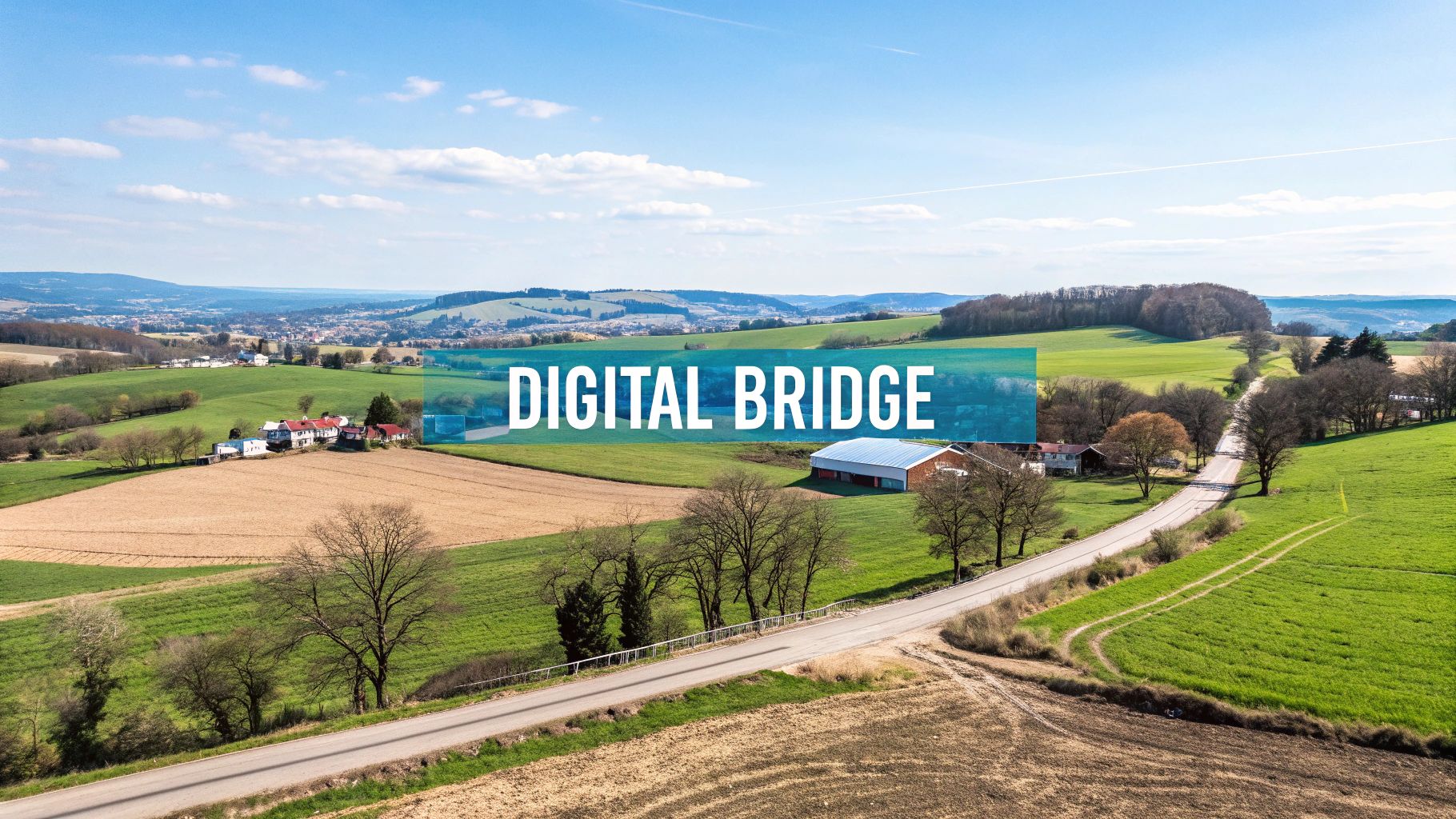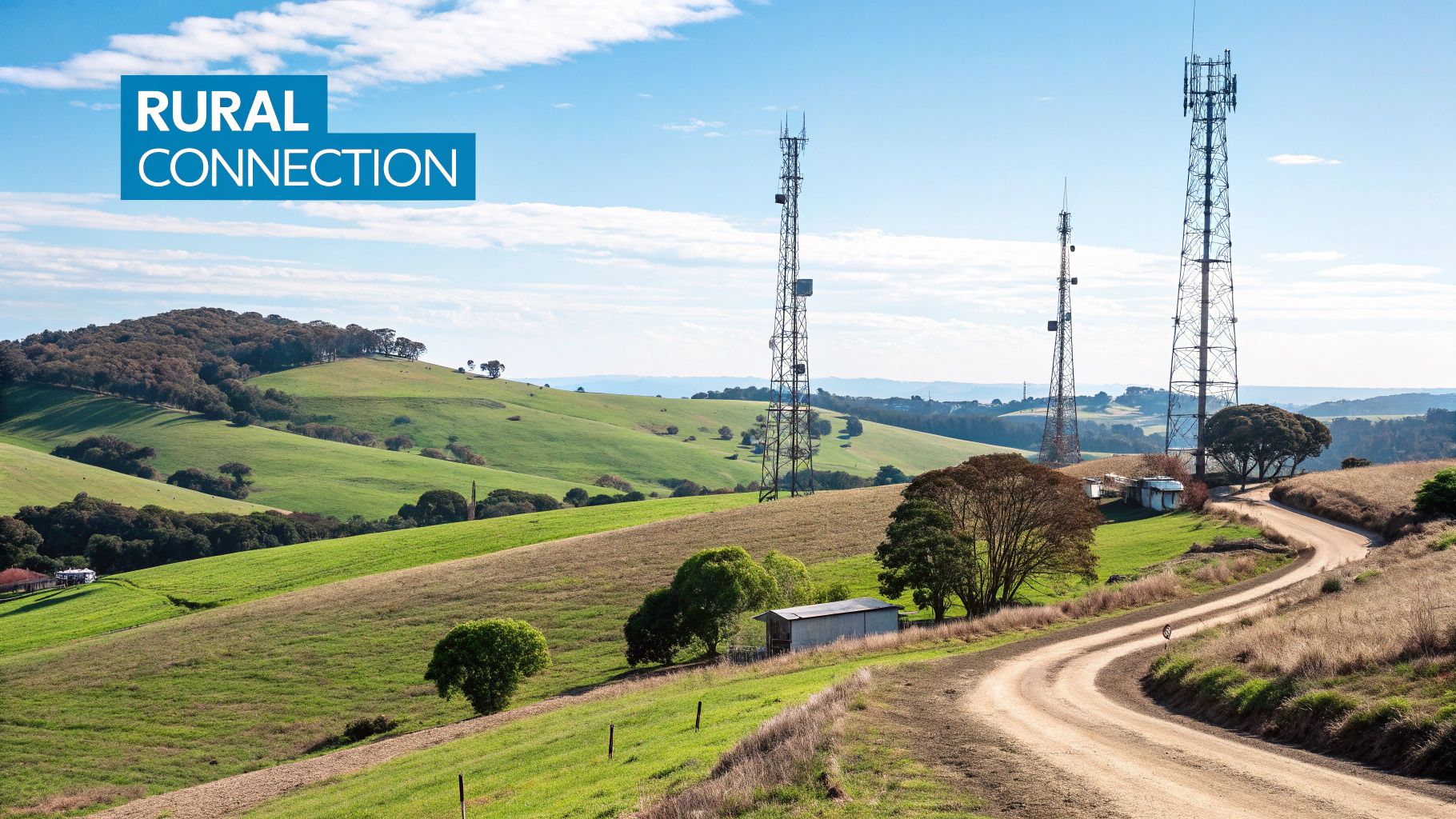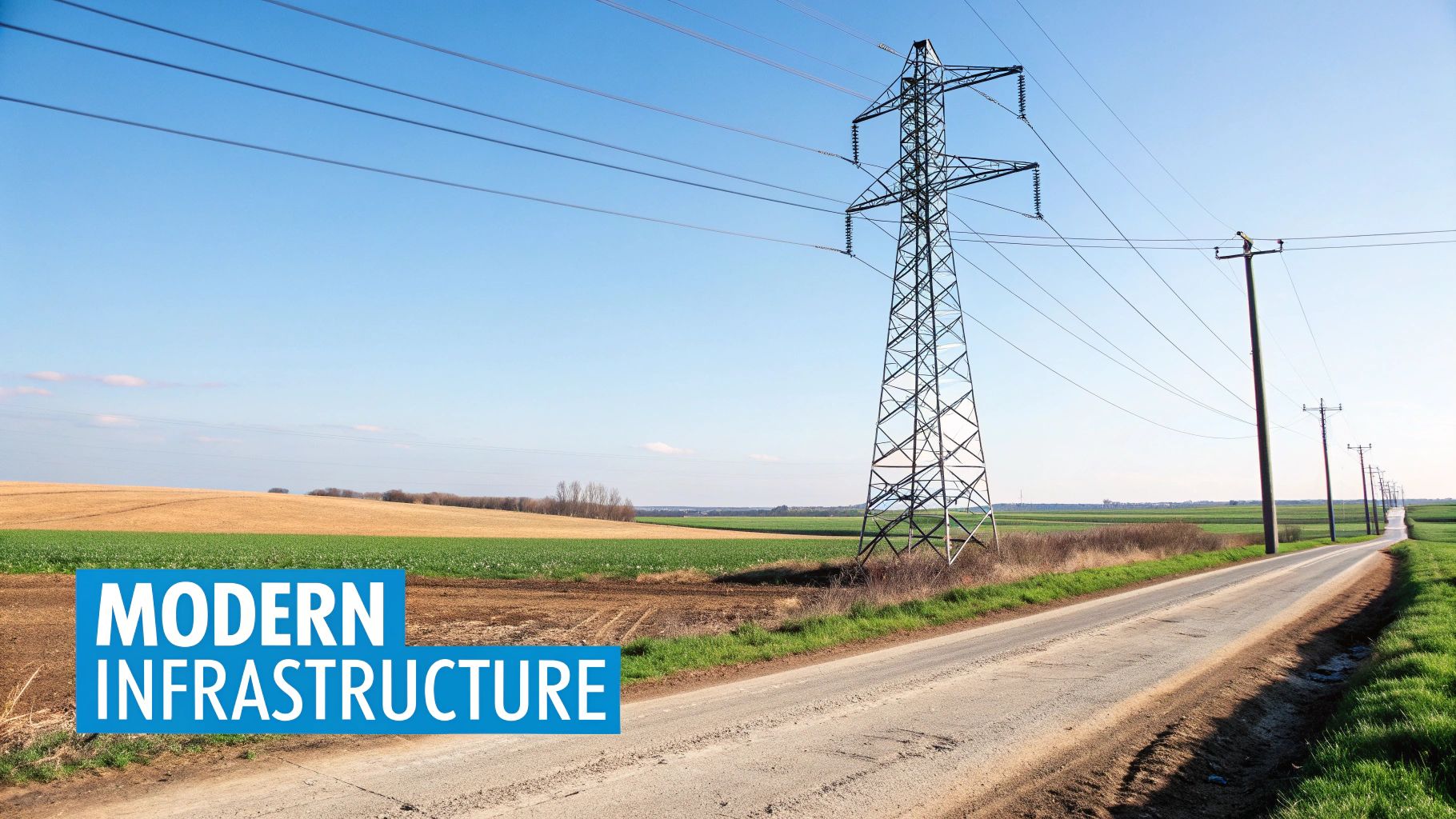

· Por James
Rural High Speed Internet: Bridging the Digital Divide
The Reality of Rural Connectivity Today

Reliable high-speed internet access is no longer a luxury, but a necessity. Yet, for many living in rural communities, consistent connectivity remains elusive. This disparity between urban and rural internet access creates a significant obstacle for rural residents, impacting their ability to access vital services like healthcare and education, and limiting economic prospects.
The Digital Divide: Urban vs. Rural
The gap in internet access between urban and rural areas is what we call the digital divide. This divide isn't merely about convenience; it's a fundamental issue of equity. Urban areas, with their denser populations, tend to attract numerous Internet Service Providers (ISPs). This competition often translates to faster speeds, more competitive pricing, and better service.
Rural areas, on the other hand, present significant challenges for ISPs. The lower population density increases the infrastructure cost per household, making these areas less attractive for investment. This disparity leaves many rural communities underserved.
Challenges in Rural Internet Deployment
Bringing high-speed internet to rural areas presents unique obstacles. The sheer geographical distances and often challenging terrain make deploying infrastructure like fiber optic cables or cell towers expensive and complex.
Furthermore, issues like securing access rights and navigating bureaucratic processes can significantly delay projects. These infrastructure limitations have a direct impact on the availability and affordability of high-speed internet for rural residents.
Globally, rural internet adoption rates vary widely. As of 2024, the global internet penetration rate was 68%. Urban areas boast a higher rate of 83%, while rural areas lag significantly at 48%. In some regions, like Africa, rural internet access is exceptionally low, at only about 23%. You can find more detailed statistics from Statista. These disparities underscore the ongoing struggle to connect rural communities.
The Impact of Policy and Investment
Addressing the rural connectivity gap requires effective policy decisions. Government subsidies and grants can incentivize ISPs to invest in underserved areas. Similarly, streamlining permitting processes and fostering public-private partnerships can accelerate deployment. Resources like SwiftNet Blogs offer valuable insights into the ongoing efforts to improve rural connectivity. Ultimately, closing the digital divide demands a comprehensive strategy that includes technological innovation, strategic investment, and a firm commitment to ensuring equitable access to high-speed internet for all.
Why Rural High-Speed Internet Changes Everything

Access to reliable rural high-speed internet is more than just a modern convenience. It's a fundamental requirement for progress and a driver of significant change in rural communities. This connectivity is rapidly reshaping how people live and work, how they learn, and how they access essential services, creating new opportunities.
Economic Empowerment Through Connectivity
One of the most significant impacts of rural high-speed internet is the economic boost it provides. It opens doors to remote work, allowing individuals to pursue careers previously limited by geography. This flexibility can attract skilled workers to rural areas and allows current residents to stay while pursuing fulfilling, well-paying jobs.
Rural high-speed internet also helps grow digital entrepreneurship. Small businesses can expand their reach through online platforms like Etsy and Shopify, and individuals can launch businesses from their homes. This digital marketplace removes geographical limitations and creates new economic activity in rural areas.
Bridging the Educational Gap
Reliable internet is crucial for education. Rural high-speed internet creates a more level playing field, giving rural students access to the same online learning resources as their urban peers. This access goes beyond K-12, allowing adults to pursue online higher education and vocational training programs.
This access to educational resources is especially important for rural communities. These areas often have limited access to traditional schools and colleges. Online learning encourages lifelong learning and develops a skilled workforce, boosting economic growth and community development.
Transforming Healthcare Delivery
Rural high-speed internet is changing healthcare in rural areas. Telemedicine allows patients to connect with specialists remotely, overcoming distance and improving access to care. This is particularly beneficial in areas with few healthcare facilities. Patients can access specialists through platforms like Teladoc.
However, the digital divide presents a serious challenge. As of 2024, the International Telecommunication Union (ITU) reported approximately 1.8 billion people in rural areas were offline. This lack of connectivity limits access to vital services and widens the gap between urban and rural communities. Expanding rural high-speed internet is critical for promoting equity and giving everyone the resources they need.
Strengthening Community Bonds
Finally, rural high-speed internet strengthens communities. It makes communication and information sharing easier. Online platforms connect residents with local organizations, government services, and each other, building a more informed and engaged citizenry. This interconnectedness creates a sense of belonging and allows residents to participate actively in local issues, fostering a more dynamic and resilient rural environment.
Breaking Barriers: Technologies Reaching Rural Communities
Bringing high-speed internet to rural areas requires a diverse approach. There's no one-size-fits-all solution. Understanding the pros and cons of each technology is essential, and combining different technologies is often the best way to achieve truly comprehensive coverage.
Fixed Wireless: Broadband Without the Wires
Fixed wireless uses radio waves to transmit data between a base station and a receiver at the user's location. It's a significant development for rural communities because it avoids the need for extensive cabling. This makes it quicker and cheaper to install, especially in sparsely populated regions. However, fixed wireless connections can be affected by obstacles like trees and buildings, and performance decreases over long distances.
Fiber Optics: The Gold Standard
Fiber optic cables transmit data with light, offering unmatched speed and reliability. Fiber is the best internet connection available, delivering far greater bandwidth than other technologies. It's perfect for activities that use a lot of data, such as video calls and online gaming. However, the high cost of installing fiber, particularly in remote, sparsely populated areas, can make it too expensive for widespread use. Strategic placement, such as connecting community centers or businesses, is a vital consideration.
Satellite Internet: Reaching the Unreachable
Satellite internet sends signals directly from satellites orbiting Earth. This makes it the only real choice for very remote locations that can't access ground-based infrastructure. While satellite internet has traditionally been known for high latency and slow speeds, new satellite networks are changing the game. These systems offer much lower latency and significantly higher speeds, making satellite a more viable option for rural areas.
Choosing the Right Technology
The best internet technology for a specific area depends on various things. Geography, like hills and distances, is a major factor. The existing infrastructure and the affordability of different options also play a role.
For example, fixed wireless might be a good choice for a relatively flat area with a reasonable population density. But for a remote mountain village, satellite internet may be the only practical answer. In areas with a higher population density and existing fiber networks, expanding that fiber network strategically often provides the best solution in the long term.
Understanding the particular needs and challenges of each rural community is crucial. This table summarizes the key aspects of each technology:
To help you compare the options available for rural internet access, we've compiled this table:
Rural Internet Technology Comparison: This table compares different technologies used to deliver high speed internet to rural areas, showing their typical speeds, costs, infrastructure requirements, and ideal use cases.
| Technology | Typical Speeds | Infrastructure Required | Relative Cost | Best For |
|---|---|---|---|---|
| Fixed Wireless | Moderate | Line-of-sight to tower | Moderate | Moderately populated rural areas |
| Fiber Optics | Very High | Extensive cabling | High | Densely populated areas, town centers |
| Satellite Internet | Improving, variable | Satellite dish | Moderate-High | Remote locations, limited infrastructure |
Knowing the strengths and weaknesses of each technology allows us to effectively bridge the digital divide and bring the advantages of high-speed internet to everyone in rural communities.
Rural Connectivity Success Stories That Actually Worked

Connecting rural communities to high-speed internet takes more than just the right technology. It requires innovative strategies, community involvement, and strong partnerships. This section highlights success stories that show how bridging the digital divide can truly transform rural areas. These examples offer practical lessons for communities looking to improve their own connectivity.
Community-Owned Networks: Empowering Local Solutions
Many successful rural broadband projects begin with the initiative of the communities themselves. Some towns, for example, have created community-owned networks. Residents pool their resources and expertise to build and maintain their own internet infrastructure.
This model encourages local ownership and makes sure the network addresses the community's specific needs. This community-driven approach is especially effective in areas where traditional ISPs hesitate to invest because of perceived low profitability. By taking matters into their own hands, these communities show the power of local action.
Public-Private Partnerships: Leveraging Shared Resources
Another effective strategy involves creating public-private partnerships. These partnerships combine government resources and expertise with the efficiency and innovation of private companies.
This collaboration can greatly reduce the financial burden on both sides, making projects much more achievable. For example, a local government might provide access to public land for infrastructure, while a private ISP invests in the equipment and technical skills. This kind of partnership can speed up deployment and expand the reach of rural high-speed internet.
Innovative Funding: Making Projects Viable
Finding the necessary funding is often a major obstacle for rural broadband projects. However, successful initiatives show the possibilities of creative funding solutions.
Some communities have used grant programs and subsidies to lower infrastructure costs. Others have explored innovative financing models like crowdfunding or community bonds. These approaches can make projects viable even with limited resources.
Measuring Success: Quantifiable Benefits
The real measure of success is the positive impact of high-speed internet on rural communities. These projects have noticeably improved access to education, healthcare, and economic opportunities.
For example, students in connected communities have shown better academic performance, and businesses have seen increased productivity and revenue. In the European Union, the percentage of rural homes with high-speed internet grew dramatically from 4% in 2013 to 37% by 2021. You can find more statistics here: World Economic Forum - Rural Internet Access in the EU. This progress highlights the effectiveness of dedicated work and focused investments.
Sharing Success: Inspiring Future Connections
You might also be interested in: SwiftNet Sitemaps. These real-world outcomes demonstrate the transformative power of connectivity and the importance of continued investment in rural high-speed internet. By sharing these successes, we can encourage and empower other communities to build their own connected futures.
Smashing Obstacles to Rural High Speed Internet
Access to rural high-speed internet has become essential for everything from education and healthcare to economic development. However, significant obstacles still prevent widespread availability. This section explores these challenges and examines practical solutions for connecting underserved rural communities.
Funding and Economic Barriers
A primary hurdle is the economic challenge of deploying infrastructure in sparsely populated areas. The cost of laying fiber optic cables or building cell towers can be prohibitive when distributed across fewer households. This is where innovative funding mechanisms are crucial.
Government subsidies and grants, like those available through the Rural Digital Opportunity Fund, can incentivize private companies to invest in these underserved areas. Exploring alternative funding models, such as community-owned networks or public-private partnerships, can also distribute the financial burden and improve project viability.
Regulatory Hurdles and Streamlining
Another obstacle is navigating the regulatory landscape. Complex permitting processes and securing access rights can significantly delay projects. Streamlining these processes and fostering collaboration between government agencies and Internet Service Providers (ISPs) is key to faster deployment.
For example, establishing clear guidelines for right-of-way access and creating a single point of contact for permit applications can eliminate bureaucratic bottlenecks, saving valuable time and resources.
Technical Innovations for Geographic Challenges
Geographic barriers, like mountainous terrain and vast distances, present unique technical challenges. Fortunately, technical advancements offer promising solutions. Fixed wireless technology can deliver broadband over long distances without extensive cabling.
Next-generation satellite constellations, like Starlink, offer improved speeds and lower latency for even the most remote locations. These solutions must be tailored to the specific geographic context, recognizing that a one-size-fits-all approach won't work. Learn more about rural internet options.
Addressing Digital Literacy and Adoption
Beyond infrastructure, a critical yet often overlooked barrier is the digital literacy gap. Even with high-speed internet access, some residents lack the skills and confidence to use it effectively. Community programs providing digital literacy training and support can empower individuals to fully utilize the benefits of connectivity.
Addressing any resistance to adoption through community engagement and demonstrating the practical advantages of internet access, such as telehealth and online education, can also encourage greater uptake.
To better understand the barriers and solutions, let's look at the following table:
This table identifies the major barriers to rural high-speed internet deployment and presents corresponding solutions proven effective in various contexts.
| Barrier Category | Specific Challenges | Potential Solutions | Implementation Examples |
|---|---|---|---|
| Funding | High infrastructure costs in low-density areas | Government subsidies, public-private partnerships, community networks | Rural Digital Opportunity Fund, community-owned fiber networks |
| Regulation | Complex permitting and access right processes | Streamlined regulations, single point of contact | Standardized application processes, inter-agency collaboration |
| Geography | Mountainous terrain, vast distances | Fixed wireless, next-generation satellite internet | Wireless towers on elevated terrain, Starlink satellite network |
| Digital Literacy & Adoption | Lack of skills, resistance to new technology | Digital literacy training, community engagement programs | Public library computer classes, community technology workshops |
As the table illustrates, a combination of financial incentives, regulatory improvements, and technological advancements are essential to overcome the challenges. Community engagement is key to ensuring widespread adoption.
Bridging the Divide: A Multi-Faceted Approach
Ultimately, overcoming the obstacles to rural high-speed internet requires a multi-faceted approach. It demands tackling financial constraints, streamlining regulations, leveraging technological advancements, and fostering digital inclusion. By addressing these challenges, we can ensure that the benefits of connectivity reach all corners of our society, empowering rural communities and bridging the digital divide.
The Future of Rural Connectivity Is Happening Now

The rural high-speed internet landscape is rapidly changing. This section explores the exciting developments poised to reshape rural connectivity in the years to come. We'll examine how these innovations can deliver reliable internet access to even the most remote areas.
Expanding Satellite Constellations: Reaching for the Stars
One of the most promising advancements is the expansion of satellite internet constellations. These networks of low-earth orbit satellites are set to revolutionize internet access for those in isolated locations. Offering lower latency and higher speeds than traditional satellite internet, these systems provide a viable solution for bridging the digital divide. Initiatives like Starlink exemplify this progress, bringing high-speed internet to formerly unconnected communities.
Advanced Wireless Technologies: Extending the Reach
Beyond satellites, advancements in wireless technologies are also extending the reach of rural high-speed internet. Fixed wireless solutions, which beam internet signals directly to homes and businesses, are becoming increasingly efficient and affordable. This makes them a practical choice for areas where laying fiber optic cable is cost-prohibitive.
Hybrid Approaches: Combining Technologies for Resilience
We're seeing a rise in hybrid approaches to rural internet connectivity. These strategies combine multiple technologies, like fixed wireless and satellite, to deliver resilient and adaptable coverage. If one connection type is temporarily unavailable, another can seamlessly take over, ensuring a consistent internet experience.
Evolving Business Models and Policy
The push for rural high-speed internet also involves changes in funding and regulation. New business models focusing on community ownership and public-private partnerships are emerging, making rural deployment more sustainable. The policy landscape is also shifting, with government subsidies and grants incentivizing investment in underserved areas.
Towards Universal Access: A Hopeful Future
The timeline for achieving universal rural high-speed internet access varies depending on the region. However, recent progress paints a hopeful picture. As more communities gain access to reliable internet, we can anticipate a significant positive impact, including increased economic opportunities, improved access to education and healthcare, and stronger community connections. The future of rural connectivity is unfolding now, promising a more connected world.
Ready to see the difference high-speed internet can make? Visit SwiftNet Wifi today to learn more about our 5G internet options for rural areas and RV travelers.
Article created using Outrank

